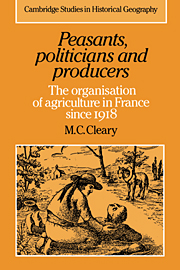Book contents
- Frontmatter
- Contents
- List of figures
- List of tables
- Preface
- Abbreviations
- Base map of the départements of France
- Introduction
- 1 The transformation of rural France
- 2 Individuals and associations in the farming community
- 3 Agricultural associations before 1914
- 4 The heyday of the regional unions, 1918–1930
- 5 The economic crisis and the rise of corporatism, 1930–1940
- 6 Agricultural associations under Vichy, 1940–1944
- 7 A rural revolution? Syndicates and cooperatives, 1944–1965
- 8 The deceptions of progress, 1965–1985
- 9 Representing the community – the place of salaried labour and women
- 10 Conclusion
- Notes
- Bibliography
- Index
2 - Individuals and associations in the farming community
Published online by Cambridge University Press: 28 October 2009
- Frontmatter
- Contents
- List of figures
- List of tables
- Preface
- Abbreviations
- Base map of the départements of France
- Introduction
- 1 The transformation of rural France
- 2 Individuals and associations in the farming community
- 3 Agricultural associations before 1914
- 4 The heyday of the regional unions, 1918–1930
- 5 The economic crisis and the rise of corporatism, 1930–1940
- 6 Agricultural associations under Vichy, 1940–1944
- 7 A rural revolution? Syndicates and cooperatives, 1944–1965
- 8 The deceptions of progress, 1965–1985
- 9 Representing the community – the place of salaried labour and women
- 10 Conclusion
- Notes
- Bibliography
- Index
Summary
It is something of a paradox that French farmers, often caricatured as highly individualistic and independent, have nurtured one of the most complex and fertile networks of cooperative institutions in western Europe. Agricultural syndicates, credit and cooperative organisations, Chambers of agriculture and mutual-aid societies abound in rural France and few farmers remain outside this nexus of groups. The history of such groups reflects the tension between individual and community in the countryside – between the desire for independence and self-reliance common to many peasant societies and the necessity for cooperation in order to ensure economic survival. Out of that tension a range of such institutions has emerged – some with a longer history than others – and their general characteristics and inter-relationships are examined in this chapter.
The individual and the community
The relationship between individual and community has been an important theme in studies of the peasantry in many different parts of the world. The literature on the economics of peasant farming, especially that centred on the model of the peasant economy developed by the Chayanov school, has frequently emphasised the primacy of the peasant family as the central unit of production and consumption. Changes in family size and structure have been seen as central to production decisions in the peasant economy whose objectives, noted Franklin, were genealogical rather than strictly economic. But, as an array of anthropological and sociological literature has shown, the peasant family meant little outside of its social or community context.
- Type
- Chapter
- Information
- Peasants, Politicians and ProducersThe Organisation of Agriculture in France since 1918, pp. 21 - 32Publisher: Cambridge University PressPrint publication year: 1989

